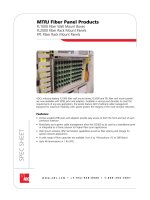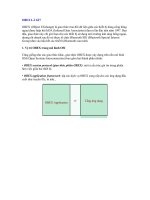Tài liệu Large-Scale MPLS VPN Deployment ppt
Bạn đang xem bản rút gọn của tài liệu. Xem và tải ngay bản đầy đủ của tài liệu tại đây (1.26 MB, 32 trang )
Large-Scale MPLS VPN
Deployment
Overview
This chapter describes scalability issues encountered in large-scale MPLS VPN
networks and presents a number of solutions that allow these networks to scale
while growing.
It includes the following topics:
n MP-BGP Scalability Mechanisms
n Partitioned Route Reflectors
Objectives
Upon completion of this chapter, you will be able to perform the following tasks:
n Understand the MP-BGP scaling issues in large-scale MPLS VPN backbones
n Describe the built-in scalability mechanisms
n Design and implement networks using partitioned BGP route reflectors
2 Large-Scale MPLS VPN Deployment Copyright 2000, Cisco Systems, Inc.
MP-BGP Scalability Mechanisms
Objectives
Upon completion of this section, you will be able to perform the following tasks:
n Understand MP-BGP scaling issues
n Describe the automatic filtering in MP-BGP
n Describe the functions of the BGP Route Refresh feature
n Describe the Outbound Route Filter feature and its benefits
Copyright 2000, Cisco Systems, Inc. Large-Scale MPLS VPN Deployment 3
© 2000, Cisco Systems, Inc. www.cisco.com Chapter#4-5
Scaling
Scaling
• Existing BGP techniques can be used to
scale the route distribution: route
reflectors
• Each edge PE router needs only the
information for the VPNs it supports
§ Only routes for VRFs are configured on the
PE router
• Route-reflectors are used to distribute
VPN routing information
A network designer that wants to design a scalable MPLS VPN solution is always
faced with a number of scalability issues, several of them being related to the
MPLS VPN architecture:
n MPLS VPN uses internal BGP (IBGP) to propagate VPNv4 routes between
PE routers. Default IBGP implementation requires a full-mesh of BGP
sessions between PE routers—a design that is only appropriate for very small
networks.
n As the number of MPLS VPN customers grows, the PE routers have to store
more and more customer routes (in traditional overlay VPN implementations,
the customer routes are not seen by the provider routers—this issue is
therefore not present in overlay VPN implementations). In very large MPLS
VPN networks, providing connectivity to large customers, the number of
routes that need to be stored by the PE routers exceeds the current scaling
capabilities of Cisco IOS BGP implementation as well as memory and CPU
resources of the PE routers.
The IBGP full-mesh scalability roadblock is easily removed using traditional BGP
scaling tools—BGP route reflectors and BGP confederations (both of them
are described in the appropriate lessons of the BGP curriculum and their operations
will not be discussed further in this section).
Note BGP route reflectors are a preferred scalability tool for MPLS VPN networks and
their positioning will be covered extensively in the next section.
4 Large-Scale MPLS VPN Deployment Copyright 2000, Cisco Systems, Inc.
The memory and CPU requirements imposed on a PE router by a large number of
customer routes can be easily reduced if the PE router only stores routes relevant
to the VPN customers connected to it and ignores all the other VPNv4 routes. The
incoming route filtering had to be configured manually with early MPLS VPN
implementation. To reduce the configuration complexity, Cisco IOS releases
12.0(7) T and 12.1 provide automatic filtering of incoming Multi-protocol BGP
(MP-BGP) updates.
Copyright 2000, Cisco Systems, Inc. Large-Scale MPLS VPN Deployment 5
© 2000, Cisco Systems, Inc. www.cisco.com Chapter#4-6
Automatic MP-BGP
Updates Filtering
Automatic MP-BGP
Updates Filtering
• The non-reflecting PE router discards
any VPN-IPv4 route that hasn’t a route-
target that is configured to be imported
in any of the attached VRFs
• This reduces significantly the amount of
information each PE has to store
• The size of the BGP table is proportional
to the number of VRFs configured on
the PE router
The automatic MP-BGP updates filtering uses a very simple algorithm—all
VPNv4 routes received by a PE router that do not correspond to any VRF
configured on the router are automatically ignored. This usually results in a
significant reduction of VPNv4 BGP table on the PE router, as the size of the table
becomes proportional to the number of VRFs configured on the PE router and not
the overall size of the MPLS VPN network.
6 Large-Scale MPLS VPN Deployment Copyright 2000, Cisco Systems, Inc.
© 2000, Cisco Systems, Inc. www.cisco.com Chapter#4-7
Automatic MP-BGP Updates
Filtering
Automatic MP-BGP Updates
Filtering
• Each VRF has an import and export policy based on a
route-target - extended BGP community
• If the route-target in an incoming MP-BGP update is
equal to any of the import values configured in this PE
router, the update is accepted, otherwise it is silently
discarded
• The automatic filtering only works for non-reflecting
routers; when the first route-reflector client is
configured, the update filtering is disabled
PE
MP-iBGP sessions
VRFs for VPNs
yellow
green
VPN-IPv4 update:
RD:Net1, Next-hop=PE-X
SOO=Site1, RT=Green,
Label=XYZ
VPN-IPv4 update:
RD:Net1, Next-hop=PE-X
SOO=Site1, RT=Red,
Label=XYZ
Import RT=yellow
Import RT=green
The filtering of incoming VPNv4 update is performed based on import route-
targets configured in VRFs and the route targets attached to incoming VPNv4
routes. If the incoming VPNv4 route carries a route target that corresponds to an
import route target of at least one VRF, the incoming route is potentially useful as it
might get inserted into the VRF and is accepted by the PE router. Otherwise the
incoming route is silently discarded (similar to other inbound BGP filtering
mechanisms).
Note The incoming VPNv4 route that is accepted by automatic inbound filter might still
be rejected by import route-map configured in the VRF, so the automatic filters
are not perfect. Anyhow, taking import route-maps in consideration when filtering
incoming VPNv4 updates would significantly increase the CPU load of the PE
router.
The automatic inbound filters only work for PE routers that do not act as route
reflectors. As there is no mechanism through which a route reflector might
discover that one of its clients would need routes with a certain route target, the
route reflectors do not filter inbound updates. The route reflectors therefore carry
all VPNv4 routes in an MPLS VPN network.
Note A router starts acting as a BGP route-reflector the moment the first route-reflector
is configured client with neighbor route-reflector-client configuration command.
As soon as the first route-reflector client is configured, the automatic inbound
filtering of VPNv4 routes is disabled.
The figure above shows an example of inbound filters. The PE router has two
VRFs configured, one accepting routes tagged with route-target green, the other
Copyright 2000, Cisco Systems, Inc. Large-Scale MPLS VPN Deployment 7
one accepting routes tagged with route-target yellow. When an incoming BGP
update carries a VPNv4 route with RT=green, the route is accepted. A VPNv4
route that only carries route target red is rejected, as red is not configured as an
import route target of any VRF on this router.
8 Large-Scale MPLS VPN Deployment Copyright 2000, Cisco Systems, Inc.
© 2000, Cisco Systems, Inc. www.cisco.com Chapter#4-8
MPLS-VPN Scaling
Route Refresh
MPLS-VPN Scaling
Route Refresh
• VPN Policies may change based on VRF modifications
§ New VRFs, removal of VRFs, change of import route targets
• The PE router may not have stored routing information, which
becomes useful after a change
• The PE router requests a retransmission MP-BGP of updates
from its neighbors
§ Route-Refresh BGP extension
PE
Import RT=yellow
Import RT=green
Import RT=red
1. PE doesn’t have red
routes (previously
filtered out)
2. PE issues a Route-
Refresh to all neighbors
in order to ask for re-
transmission
3. Neighborsre-send
updates and “red”
route-target is now
accepted
VPN-IPv4 update:
RD:Net1, Next-hop=PE-X
SOO=Site1, RT=Green,
Label=XYZ
VPN-IPv4 update:
RD:Net1, Next-hop=PE-X
SOO=Site1, RT=Red,
Label=XYZ
Automatic inbound route filters behave in exactly the same way as manually
configured BGP inbound filters. Whenever the routing policy is changed (and the
inbound filter is changed), the router might need routes that it has discarded
previously. However, there is no mechanism that the router might use to request
those routes from its BGP neighbors and the neighbors will never send those routes
by themselves, as BGP has no periodic update mechanism.
Classical BGP implementation on Cisco IOS offers two ways to get the routes
needed by a BGP router after a change in routing policy:
n The BGP session between the routers might be manually torn down and the
neighbor will send all the routes after the session is reestablished.
n The BGP router might store an extra copy of routes sent by the neighbors.
Neither of these options is a viable option for large-scale MPLS VPN deployment
because:
n Disruption of a BGP session results in a disruption of MPLS VPN service
which is not acceptable for mission-critical customer traffic.
n Storing extra copies of BGP routes would defy the whole purpose of automatic
inbound filters.
An extension to BGP, called BGP route refresh, was therefore introduced to
BGP and subsequently implemented in Cisco IOS to allow a BGP router to
request a resend of all BGP routes from its neighbor.
Note To optimize the amount of the BGP traffic exchanged between the PE routers, the
route-refresh message specifies the address family where the refresh is
needed. A PE router can thus request only a refresh of VPNv4 routes.
Copyright 2000, Cisco Systems, Inc. Large-Scale MPLS VPN Deployment 9
The figure above illustrates the BGP route refresh functionality:
n A PE router receives a VPNv4 route that does not contain any route target
configured as VRF import route-target on this router. The update is ignored.
n A new VRF is configured on the PE router and the update that was previously
ignored is now needed to gain connectivity for this new VRF. The PE router
therefore sends a route-refresh message to its neighbors, requesting a resend
of all their VPNv4 BGP routes.
n Routing update containing all VPNv4 routes is sent by the neighbor receiving
route-refresh message. This update includes the routes that were previously
discarded by inbound route filters.
n The modified inbound route filter accepts the VPNv4 route with red route-
target and the new VRF is populated.
10 Large-Scale MPLS VPN Deployment Copyright 2000, Cisco Systems, Inc.
© 2000, Cisco Systems, Inc. www.cisco.com Chapter#4-9
MPLS-VPN Scaling
Outbound Route Filters - ORF
MPLS-VPN Scaling
Outbound Route Filters - ORF
• Non-reflecting PE routers will discard updates with
unused route-target
• To optimize resource utilization, these updates
should NOT be sent
• Outbound Route Filter (ORF) allows a PE router to tell
its neighbors which routes to filter in outbound BGP
updates
PE
Import RT=yellow
Import RT=green
1. PE doesn’t need
red routes
2. PE issues a ORF
message to all neighbors
in order not to receive red
routes
VPN-IPv4 update:
RD:Net1, Next-hop=PE-X
SOO=Site1, RT=Red,
Label=XYZ
3. Neighbors
dynamically configure
the outbound filter and
send updates
accordingly
VPN-IPv4 update:
RD:Net1, Next-hop=PE-X
SOO=Site1, RT=Green,
Label=XYZ
Automatic inbound filters on the PE routers are clearly suboptimal:
n The sending router spends its resources generating the BGP update.
n Network bandwidth is used to propagate the update.
n Receiving router spends its resources filtering the incoming update, only to
discard the unnecessary route at the end.
The only way to reduce the overall resource usage would be to filter the BGP
update at the sending router as it’s being generated. The sending router, however,
has no information on the inbound filter of the receiving router.
The outbound route filter (ORF) functionality introduced in BGP gives the
receiving BGP router a way of downloading its inbound filter as an outbound filter
of the sending router. Using ORF functionality, the receiving PE router can make
sure that the sending PE router will discard all the routes that would be discarded
by the receiving router, prior to sending the information to the receiving router.
Note The filtering capabilities of outbound route filters are severely limited when
compared to the richness of BGP filters. The only two BGP filtering mechanisms
currently supported by ORF are filters based on prefix-lists and automatic
inbound filters based on MPLS VPN route targets.
The figure above illustrates the ORF functionality.
n The receiving PE router generates its automatic inbound filter permitting only
VPNv4 routes with route-target yellow or green and downloads that filter as
outbound filter to the sending PE router.
Copyright 2000, Cisco Systems, Inc. Large-Scale MPLS VPN Deployment 11
n The sending PE router will use this filter and discard the route carrying route-
target red before it’s sent to the receiving router.
12 Large-Scale MPLS VPN Deployment Copyright 2000, Cisco Systems, Inc.
Summary
Large-scale MPLS VPN deployments are usually faced with a number of
scalability issues:
n The number of PE routers in the network is large and the corresponding MP-
IBGP full-mesh does not scale.
n The amount of VPNv4 routing information in the network exceeds the scaling
capabilities of BGP routers.
Scalable MP-IBGP design can be implemented using standard BGP scalability
tools—BGP route-reflectors or BGP confederations.
The amount of VPNv4 routing information held by a PE router is reduced with
automatic inbound filters. These filters discard all routes that are not relevant to the
PE router (the routes that do not contain any route-targets configured as import
route-targets on the PE router).
Configuration changes on the PE router might change the automatic inbound filter.
As BGP routers don’t send periodic routing information refreshments, a
mechanism is needed to request missing information from other BGP routers – the
bgp route-refresh functionality.
Outbound route filters are an additional optimization of automatic inbound filters.
Through this function, a BGP router can download its inbound filter as an outbound
filter of its neighbor, reducing its CPU utilization and the amount of BGP traffic in
the network.
Review Questions
n Describe BGP scaling issues in a MPLS VPN network.
n Describe built-in MP-BGP scalability mechanisms.
n Why does the automatic filtering of inbound VPNv4 updates increase MPLS
VPN scalability?
n What are the implications of automatic inbound filtering on BGP route-reflector
design?
n Why do you need route-refresh functionality?
n When would a router send a route-refresh request to its neighbors?
n What is an outbound route filter (ORF)?
n Why are outbound route filters useful?









